Geology Reference
In-Depth Information
a)
b)
N_D_diff
N_D_diff
2.8
0.3
0.5
0.3
0.25
0.25
0.4
2.6
0.2
0.2
0.3
2.4
0.15
0.15
0.2
0.1
0.1
2.2
0.1
0.05
0.05
0
0
2
0
0
0
70
80
90
DT (
μ
s/ft)
100
110
120
0
0.1
0.2
0.3
Porosity
Figure 5.23
A log data example of a laminated sand/shale sequence; (a) sonic slowness vs density, (b) density porosity vs Poisson's ratio plot.
b)
a)
0.5
0.8
0.6
0.4
0.2
0
-0.2
-0.4
-0.6
-.08
0.45
Shale
Shale
Shale
0.4
0.35
Increasing
net sand
Shale
0.3
Wet sand
Gas sand
Shale
Wet sand
Gas sand
Shale
0.25
Wet sand
Wet sand
Wet sand
0.2
Wet sand
0.15
Gas sand
Gas sand
Gas sand
0.1
0.05
0
4000
6000
8000
10000
-0.08
-0.04
0.00
0.04
0.08
Acoustic Impedance (m/s.g/cc)
Intercept
Figure 5.24
Modelled AI vs PR and intercept vs gradient for laminated sand/shale data; (a) AI vs Poisson's ratio plot, (b) AVO crossplot.
Katahara's(
2004
) model was used to calculate upscaled velocities (see
Section 8.5.2
).
tuning effects present (Cowar et al.,
1998
). The tuning
is evident at the edges of the bright reflections in
Fig. 5.26a
where the black and red loops parallel one
another. This is manifested on the top sand amplitude
map (
Fig 5.26b
) as a distinct high amplitude lineament
parallel to the edge of the accumulation. Clearly the
bright amplitudes were responsible for the discovery
but the thickness effects on amplitude suggest that the
amplitudes are not an indication of pay thickness and
that the amplitude map should not be used as the only
dataset on which to plan appraisal wells. Using seismic
amplitude and apparent thicknesses from seismic in
order to predict net pay is discussed in
Chapter 10
.
In terms of AVO, tuned responses will be more
anomalous than isolated reflections or responses
from beds less than tuning thickness.
Figure 5.27
shows the idealised AVO signature from the top
reflection of a low impedance wedge, modelled using
a simple one-dimensional reflectivity model. Clearly,
a possible pitfall is that a tuned water bearing sand
74


























































































































































































































































































































